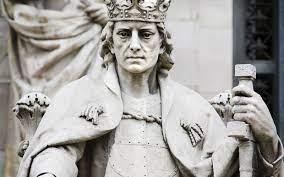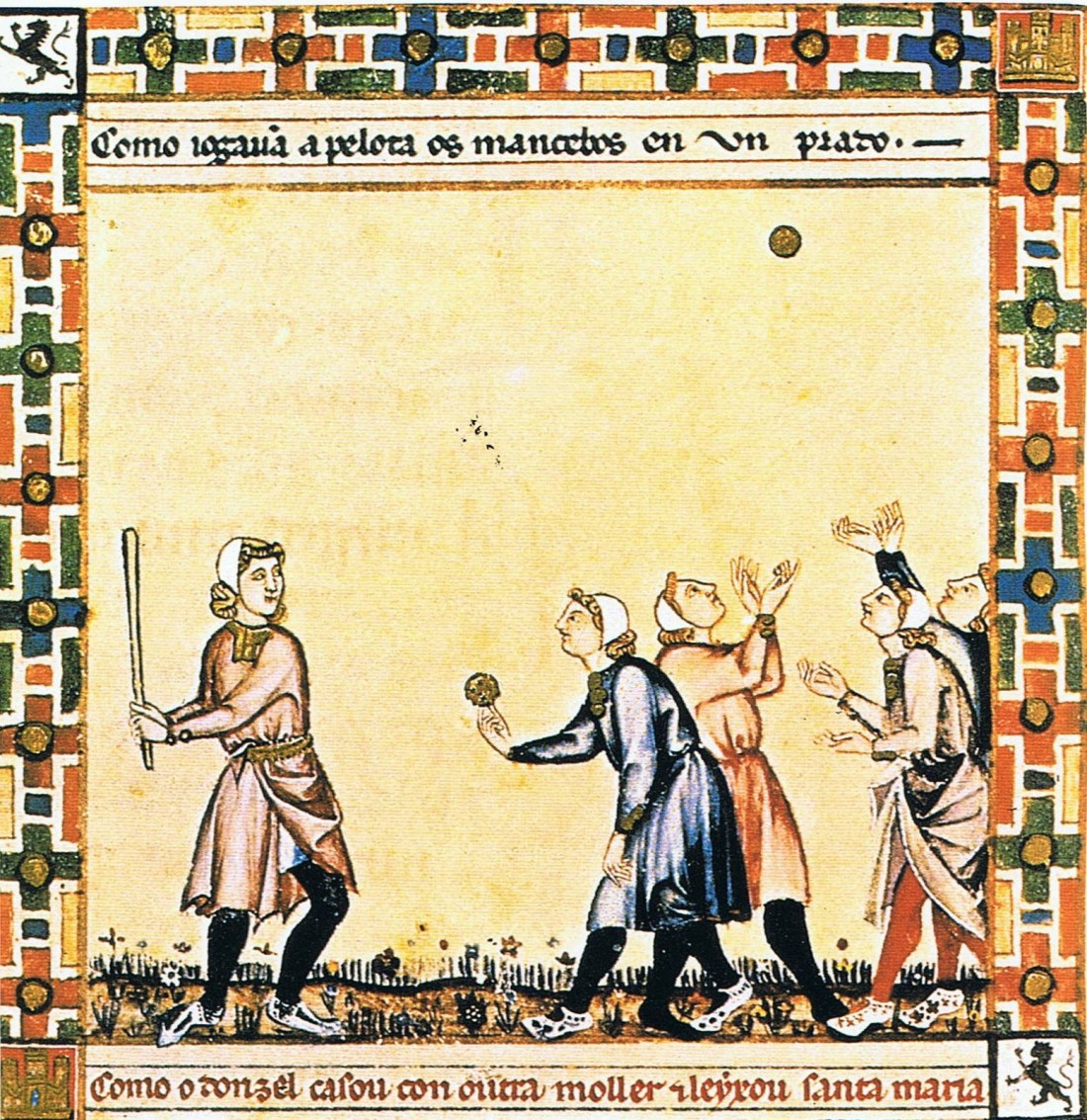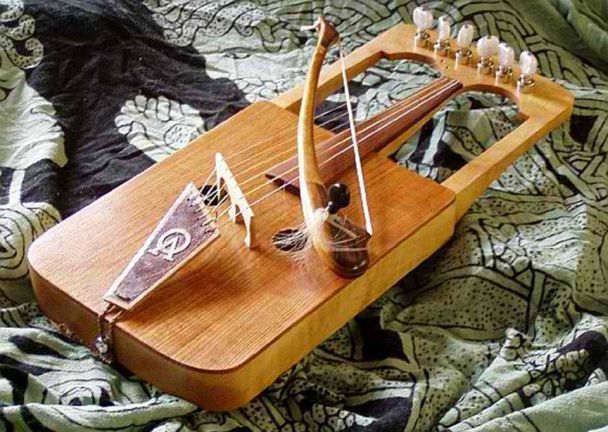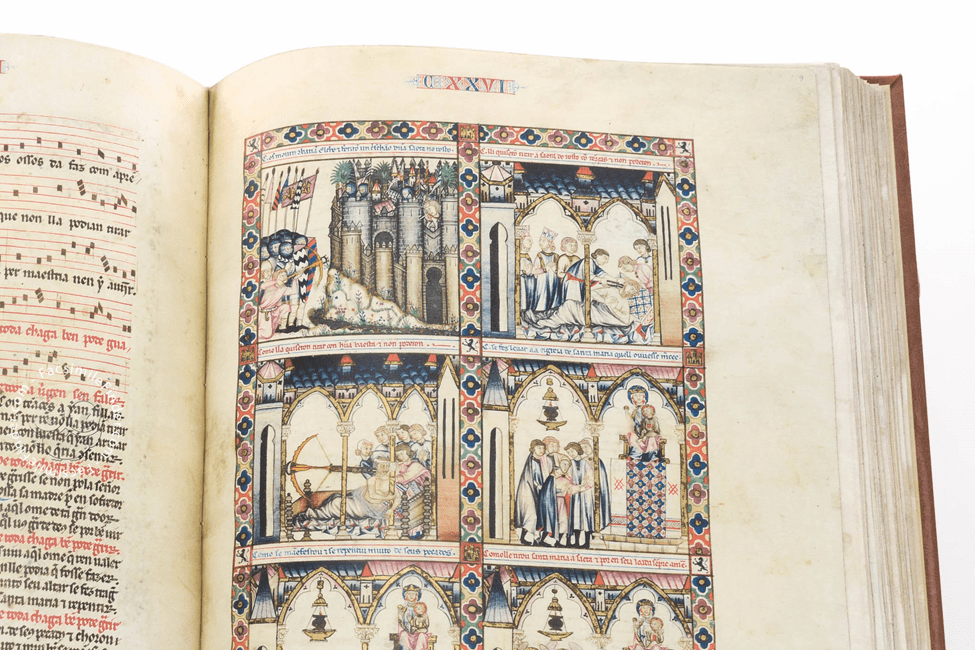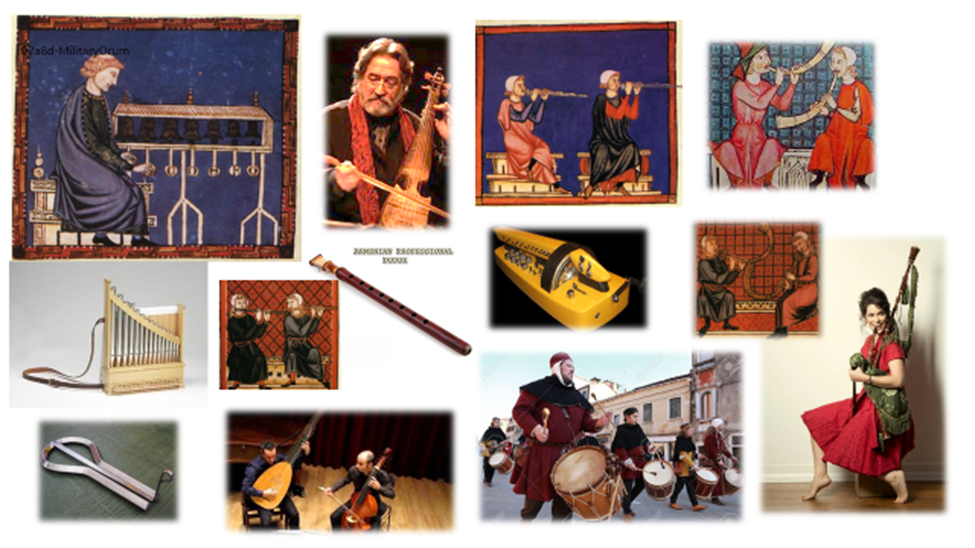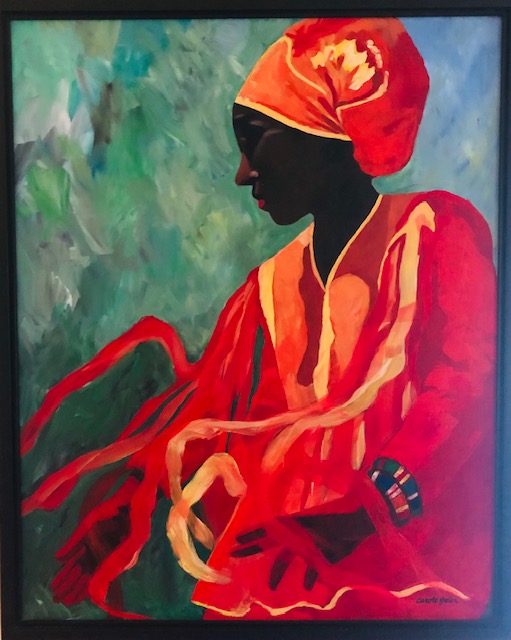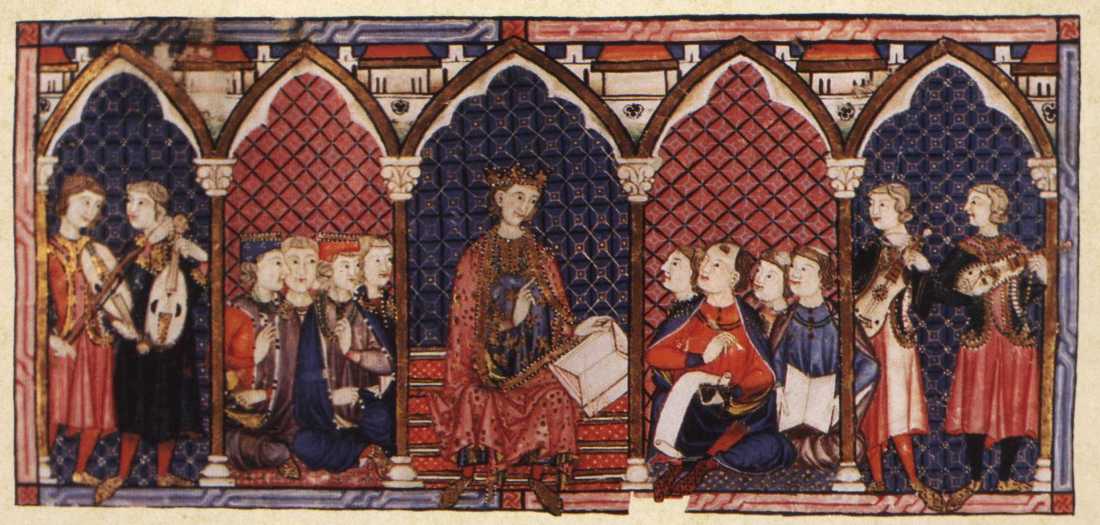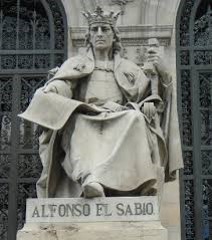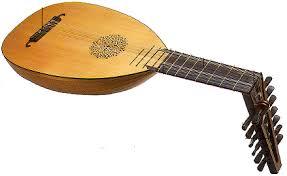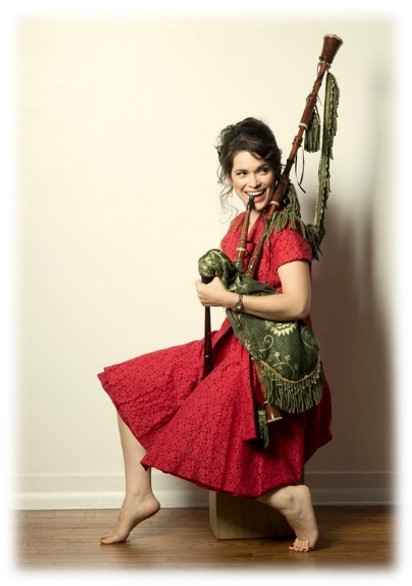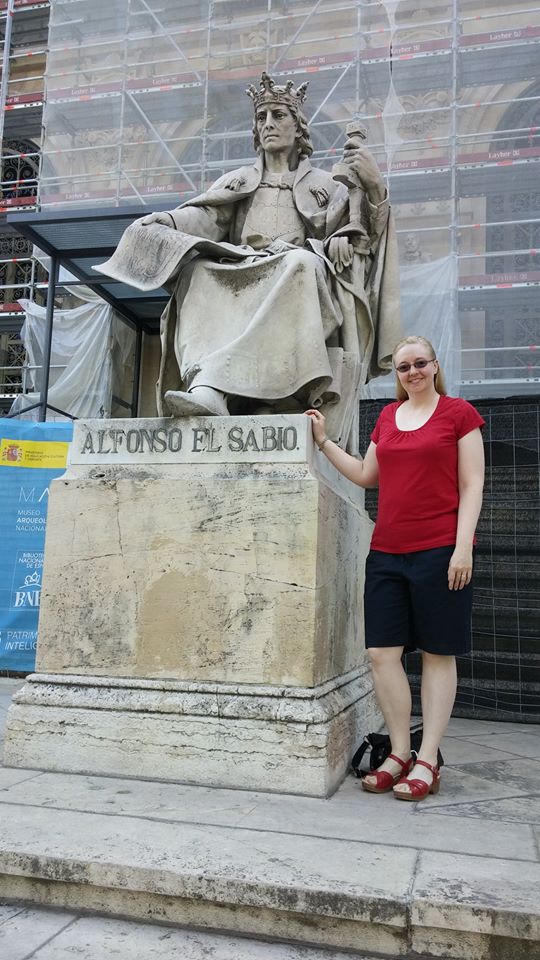This is the transcript and playlist for my annual radio program called Las Cantigas de Santa Maria, a musical biography of King Alfonso X. One place to hear the music and production is on the world wide web. http://www.hppr.org on December 22 at 2:00 p.m. Central Standard Time.
Opens with Cantiga #1 Des Oge Mais Quer’ eu Trobar
Alvaro Sanchez Guillaumet: 4:35
Hello. I’m Debra Bolton. Welcome to Las Cantigas de Santa Maria (The Holy Canticles of St. Mary), Songs and poems in praise of Holy Mary – and the poetic/musical biography of Alfonso, “the wise”, The King of Castile-Leon, now Spain, and who lived from 1221 to 1284. I’m happy you joined me today.
We began this musical journey with The Learned King declaring himself Mary’s Troubadour who will take her teaching to his Kingdom and beyond. We just heard Alvaro Sanchez Guillaumet performing CSM#1 on the Hurdy Gurdy with frame drums and Oud.
The Cantigas de Santa Maria is a collection of poems put to music. The catalog consists of more than 420 poems set to music beginning with what is called a “cantiga de loor” song of love, and every 10 song is a song of love while the others focus on scenarios related to sins and crimes with their accompanying morality story. Let’s hear the Waverly Consort in their English language interpretation of CSM #1 when the Learned King declares himself the Virgin Mary’s Troubadour and asks the “noble lady” to bestow the inheritance of eternal life and grant Alfonso’s kingdom a place in eternity. 2:43

That was the Waverly Consort led by the late Michael Jaffe with the prologue that precedes CSM# 1. You heard an English translation of the King declaring himself the Virgin’s troubadour. The first time I heard the Waverly Consort’s CSM was a live recording from the Cloisters in NYC presented on NPR. Again, of the more than 420 Marian poems written by King Alfonso X and his assistant scribes, every 10th poem is a song of love for the Virgin.
Ben Sab à Que Pod è Val “Miragre” (Mirage) Musica Iberica de Holanda (Iberian Music of Holland) 6:54
That was Ben Sab a Que Pod e Val by Musica Iberica de Holanda (Iberian Music of Holland) with a story of power and forgiveness.
King Alfonso ruled his Kingdom of Castile-Leon, now Spain, from 1252 until his death. Scholars and Alfonsine devotees continue to celebrate the Learned King’s birthday on November 23 of each year, this being his 801st year since his birth.
Let’s discuss, for a moment, the language of King Alfonso X.
In a past interview with Alfonsine scholar, Dr. J. K. Knauss, she noted that the great legacy of El Sabio is that he lived up to his name, “the wise” because he was obsessed with writing everything down. Whether it was mathematics, astronomy, the virtue of playing board games and other leisurely activities to balance hard works, laws to govern his subjects, and teaching morality, he not only wrote continually, but he chose not to write in Latin, the language of Kingdoms of the day. What made his legacy so strong is that he wrote in Galician-Portuguese, the embryonic Castilian, the present-day Spanish. The Learned King is considered the “Father of Castilian.” Was he that much of a visionary? It would seem so since Spanish only trails Chinese as the most common language worldwide, flanked by English, Arabic, Hindi, Bengali, Portuguese, Russian, Japanese, and Lahnda, aka, “Western Punjabi” according to The World Economic Forum.
In a very short phonics lesson, “Cs” and “Zs” were pronounced with a “TH” sound or a lisp, which I illustrate here in one of many miracles of in the Cantigas de Santa Maria. This is CSM#368 Maria de Cordoba y Santa Cruz de Cadiz: A woman, named Mary, lived in Cordoba next to the Church of Holy Mary the Great [the former great mosque]. She believed that she had a snake in her stomach and she travelled through Extremadura and then to Castile.
The abbot of Silos [Santo Domingo?] appeared to her in a vision and instructed her to go there. He said that the Virgin would show her how to get well.
When she got to Silos, she had another vision. This time, she was instructed to visit Santa Maria do Porto. The next day, the woman set off for that place.
When she arrived, she held a vigil and fell asleep in front of the altar. In a vision, the Virgin instructed her to go to the cathedral at Cádiz at daybreak.
She boarded a ship and they put out to see. When the people on board saw Cádiz and the church they praised the God and the Virgin.
Then the woman coughed up a red snake, like a thick eel. Everyone was amazed and praised the Virgin.
Performed by Eduardo Paniagua, the hurdy gurdy master devoted to recording all existing CSMs.
CSM#368 Maria de Cordoba y Santa Cruz de Cadiz. 6:39
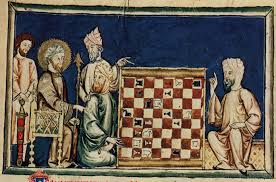
END OF SEGMENT ONE
You’re listening to this holiday special Las Cantigas de Santa Maria, the holy canticles of the Virgin Mary and musical biography of Alfonso X, the King of Castile-Leon, now Spain. I’m your host, Debra Bolton.
Alfonso X ruled from 1252 to 1284. To put the world into perspective at the time, the English language continued to change from its Germanic-rooted Olde English of the Beowulf poet (circa 9th or 10th century) after the Norman invasion of 1066. In the next century, we hear the English of Geoffrey Chaucer and the Gawain Poet. Europeans now use Arabic numerals in favor of Roman Numerals. In the Mongol Empire, Mongke, officially, marks the worship of his grandfather, Genghis Khan while Buddhism, Islam, and Christianity flourish. The Inca Empire of Peru is thriving. England begins the process of segregation of Jewish peoples, and other countries begin to follow suit. The Mexica people, also known as Aztecs, are building their great city on a lake in what is now Mexico City. King Alfonso X’s bid to be King of the Holy Roman Empire fails in favor of Count Rudolf, bringing prominence to the Habsburg family, Rudolf was considered mediocre as Alfonso was too ambitious and certainly too bright for the Pope of the time.
Let’s begin this segment with Patrizia Bovi Ensemble Micrologus and a song of love for the Virgin Mary 2:32
Cantigos de Santa Maria: Prologue instrumental (Gaita) the Galician Bagpipe: Ensemble Jehan de Channey, Vincent Aliquot, Vincent Barthelemy 1:26
CSM#159: 2:31 Talks about the Pilgrims to Rocamadour whose meat was stolen. Performed by Ensemble Jehan de Channey, Vincent Aliquot, Vincent Barthelemy.

We just heard three pieces: We began with a song of love performed by Patrizia Bovi Ensemble Micrologus and we heard the Prologue performed on the Gaita, the Galician Bagpipe and we heard CSM#159, about the Pilgrim to Rocamadour whose meat was stolen. These stories are presented as miracles that put an end to pain, suffering, and criminal ways after the Virgin intervenes.
You’re listening to Las Cantigas de Santa Maria, a musical biography of King Alfonso X, El Sabio, the wise. I’m your host, Debra Bolton.
Let us turn now to a song of love for the Virgin Mary as envisioned by King Alfonso X. This is called Eno Mome de Maria, CSM#70 performed by Universalia in Re 5:41
That was Universalia in Re performing a song of love for the Virgin Mary. You’re listening to Las Cantigas de Santa Maria, the musical biography of Medieval King of Spain, Alfonso X.

You’re listening to Las Cantigas de Santa Maria, the holy canticles of the Virgin Mary in music, poetry, and art. My name is Debra Bolton. I am your host for this special music. If you go out to my website you will find examples of some of the art that corresponds with the songs and poetry and this narrative with the songs for today’s musical program. The website is https://wordpress.com/post/peopleandcultures.blog/1728
This is CSM 13, the story of A thief named Elbo always prayed to the Virgin and commended himself to her.
One day he was caught stealing and the magistrate ordered him to be hanged.
As Elbo was hanging on the gallows, the Virgin supported his feet so that he did not choke. He stayed on the gallows for three days.
The magistrate passed by, noticed the thief was still alive, and had the rope adjusted. The Virgin continued to protect Elbo.
The thief spoke to the magistrate and his men, explaining that the Virgin had been keeping him alive. The magistrate praised the Virgin and had him taken down from the gallows. Elbo joined a monastery.
Performed by Robin Rolfhamre 5:34

You just heard the oud in that piece. The oud was the precursor to the guitar, oud being the Arabic word for wood. That was the story of Elbo, who changed his thieving ways and joined a monastery. Robin Rolfhamre is a professor of music and researcher in Sweden who plays lute, oud, and psaltry and who investigates the functions and performance of music in France in the 17th and 18th centuries.
Next, we’ll explore CSM 77-119, performed by Forfaitz. 5:12
77: A woman was almost entirely paralyzed. Her limbs were shriveled and twisted, and no medicine could cure her. On the Virgin’s feast in August, Mary straightened her limbs. Each of her limbs made a loud cracking sound as the shrunken tendons stretched. The bishop and the people who witnessed her healing wept and gave thanks to the Virgin.
78: The Count of Toulouse favored one of his courtiers. The man was devoted to the Virgin and refused to hear any mass but hers. The other courtiers were jealous of the pious man and plotted against him. They lied to the count, slandering him and accusing him of terrible crimes. The count decided to burn the man. He instructed the lime burner to throw into the fire the first man who came his way. He sent his victim on an errand to the lime burner, but, on his way, the man stopped to hear mass recited at a hermitage. The count, thinking the deed had been done, sent another man to the lime burner. This man was the one who had slandered the Count’s favorite. The lime burner seized him and threw him into the flames. When the count saw the good man alive and learned of the slanderer’s death, he realized justice had been served. He wept, praising the Virgin, and promised to have the miracle proclaimed in all her churches.
CSM 77-119, each tell a story of an afflicted person or one who engages in crimes and how each time the afflicted or the criminal cries out to the Virgin with much contrition, and low, the Virgin saves them from their disease or sentencing.
Forfaitz. 5:12
Quen a omagen – Ansambl Triola 3:04

According to Alfonsine scholar, Dr. J.K. Knauss,
King Alfonso employed artists to create two and three-dimensional works of art to correspond to the poems and songs, which would have made the Learned King an early pioneer in multi-media. Now, here we are putting it all in digital form! Some scholars point of the works of art, the songs and the poems as Alfonso’s way to teach morality to the subjects of his kingdom on many levels. While those in his court were, themselves, learned and well-educated people, there were many in his kingdom who, perhaps, could not read or write. Hence the need for the lessons on morality in more than written forms.
Regarding the language:
The poems and songs employ the language of the time, which is Galician-Portuguese, Medieval Galician, or as some linguists and historians simply call the language, Romance, the root language of Castilian, the language of Spain and its subsequent colonized countries in the Americas.
When we think about world events of King Alfonso’s time, between the 12 and 14th centuries, there was a sect of Christians called the Cathare, a
fundamentalists sect who believed there were two gods: A good one who presided over the spiritual world, and an evil one who ruled the physical world. Cathars viewed even sex within marriage and reproduction as evil, and so lived strict lives of abstention. Here I present the spoken text of the Papal Bull legislating torture of those practicing Catharism, called “Ad Exstirpanda.” Papal bulls are edicts issued by the Pope of the Catholic Church. We know the one issued in 1492 before the launching of Columbus, the edict of colonizing so called, “Non-Christian” countries and enslaving Indigenous peoples some 200 years after Alfonso X’s rule.
At odds with the Catholic church, The Cathare believed in female deities and believed that Mary Magdalene and Jesus were married. The text is presented in Latin, as the Cathar of the time were in France and Italy.
This lament, performed by Jordi Savall and Hesperion XXI Veri dulcis in tempore” translated “A true Sweet season” of the time from the CD “The Forgotten Kingdom.
Veri dulcis in tempore: 3:57
That was Jordi Savall and his Hesperion XXI performing music of the forgotten Kingdom of the Cathare in France and Italy.

After 1492, in addition to colonizing the lands and its people, Spain, also, colonized the languages of the Americas and the Caribbean. Since the so called, “first contact,” we saw Castilian overwhelming, and often erasing, many Native languages of the islands and the continents, thanks to the Doctrine of Discovery establishing a so called, “spiritual, political, and legal” justification for colonization and seizure of land NOT inhabited by visibly Christian (white) People. Again, the Spanish we hear today differs widely from that of the CSM and Alfonso X’s time. However, you don’t need to understand Galician-Portuguese to enjoy this music, known for its complex musical structures and its use of what we now call, ancient instruments.
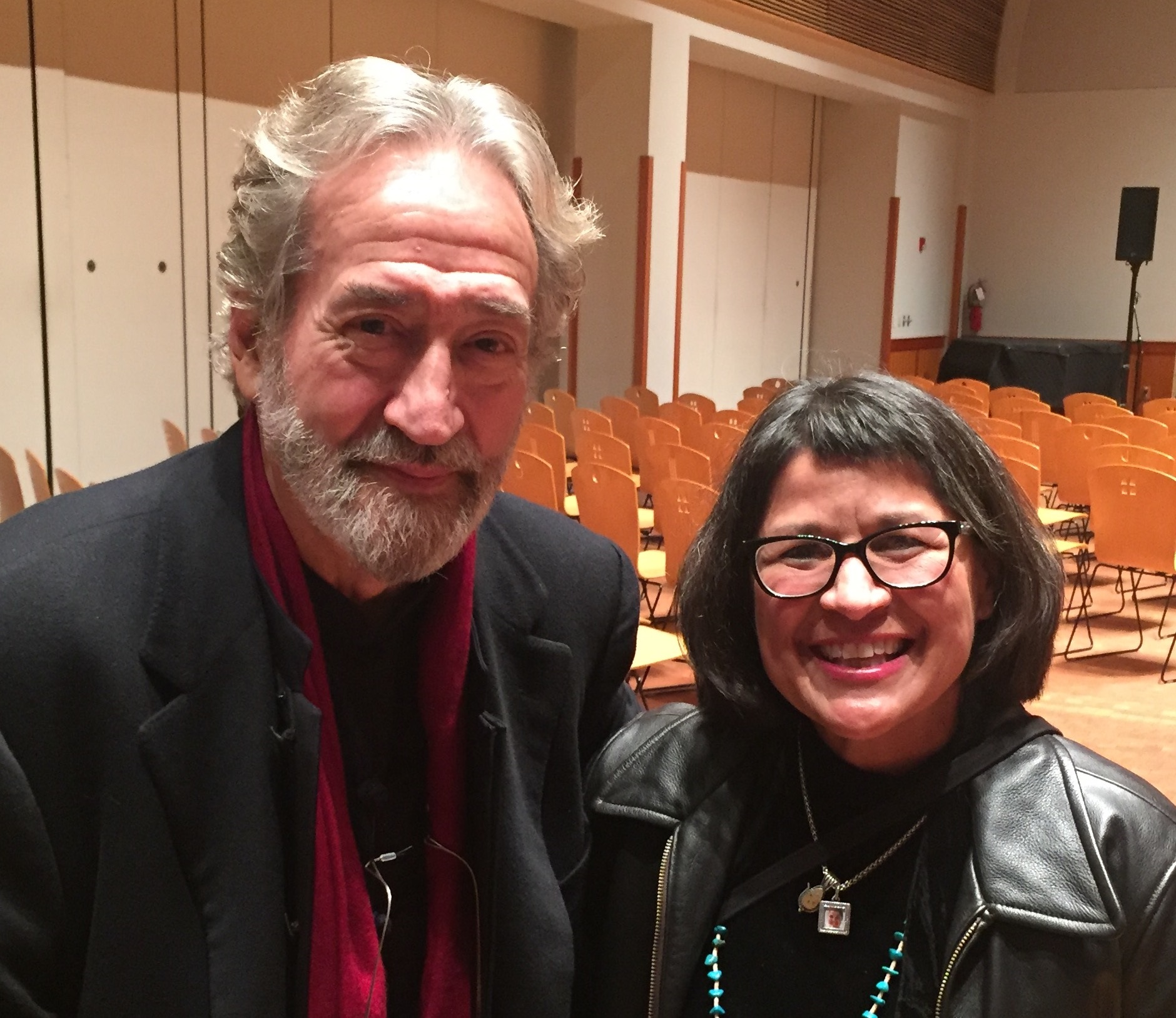
Coming up in the next hour of Cantigas de Santa Maria, we will hear more songs and tunes about miracles of the Virgin Mary as we continue this musical biography of King Alfonso X, the wise, of 13th Century Spain
Go to an instrumental played by the Waverly Consort, Cut #15, to play to the end. 6:43
Hour Two
Hello, I’m Debra Bolton. Welcome to the second hour of Las Cantigas de Santa Maria (The Holy Canticles of St. Mary), songs and poems in praise of Holy Mary – and the poetic/musical biography of Alfonso, “the wise”, The Kind of Castile-Leon, now Spain, and who lived from 1221 to 1284. I appreciate your joining me today.
As we continue in this exploration of this very small part of King Alfonso X’s tribute to the Virgin Mary, my references come from the writings of Dr. J.K. Knauss. In addition, I refer to the writing of Professor Joseph F. O’Callahan, Mr. Andrew Casson, Maestro Jordi Savall, Maestro Eduardo Paniagua, John Esten Keller, Robert I. Burn, Editor of “The Emperor of Culture” and from Oxford Univesity’s CSM database.
From Burn’s edited book, The Emperor of Culture, Ellen Kosmer and James Powers write: The period witnessed a dramatic rise in the growth of European towns. As urban economies prospered, so too did craftsmen [see a] dramatic increase in the thirteenth century. The book trade went from a monastic to a lay enterprise, which mirrored the changing society. Thus, Alfonso’s commission of this literary works, written in a vernacular, the Galician dialect, with its lavish illustrations [and 3-D art]puts him in the company of other great 13th Century royal patrons, like Louis IX (9th) of France, the southern courts of Italy, and in English with Henry III and Edward I. The CSM is distinguished from other royal works for its length, depth, and wide range of topics.
Prologue: Ensemble Scandicus : 4:36
SM Strela do dia Apollo’s Fire: 4:22

You’re listening to a musical biography of Spain’s Medieval King, Alfonso X. I’m your host Debra Bolton. We just listened to two pieces: The Prologue was performed by Ensemble Scandicus, a multicultural European group focused on early music.
Also, we heard Apollo’s Fire with Santa Maria do dia. Apollo’s Fire is a Cleveland Ohio-based early music ensemble as part of the Cleveland Baroque Orchestra.
Author J. K. Knauss describes the importance of the Cantigas de Santa Maria saying, “The most appropriate single adjective for the corpus of cultural work produced under Alfonso X is ‘encyclopedic.’” He wrote books of history, astronomy/astrology, law, poetry, board games, and music. Even his written leisure activities continue to survive the vagaries of time, bearing the King’s name as patron or author.”
Here’s the New London Consort with Quen a Virgen Ben Servira. 8:24

That was CSM#103: The Monk who listened to a Bird’s Song for Three Hundred Years, Performed by the New London Consort.
Let’s take a moment to talk about some of the instruments that you’re hearing on this musical journey of 13th Century Spain, then called, Castile-Leon.
Shawm – 12th c conical bored double reed instrument of Middle Eastern origin, a precursor of the oboe. Like the oboe, it is conically bored; but its bore, bell, and finger holes are wider, and it has a wooden disk (called a pirouette, on European shawms) that supports the lips
Recorder – Yes. That woodwind instrument that many of us learned in grade school. We hear this in the CSM, usually, on a wider variety of wood recorders.
Organetto – a small portable organ, which you heard performed by Esther Lamandier
Oud – Literally, wood in Arabic, short-necked, pear-shaped with 11 – 13 strings grouped in 5, 6, or 7 courses. A few of the oud players that stand oud are Driss El Maloumi, a group called 3MA and Haik Egitim Merkezi Yalova, both Maloumi and Yalova perform with Jordi Savall’s Hesperion groups. The Oud is considered the most important instrument in Middle Eastern Music.
Qanun (a.k.a., kanun, ganoun, kanoon) an Arabic stringed instrument, introduced to Europe in the 12th Century. It’s played on the lap with picks that surround both index fingers, and the player can change the pitch of the strings with brass levers.
Hurdy Gurdy, a.k.a. Viola de Rueda, and the Zanfona. Here we hear this instrument in Musica Antigua.
Vielle – the Medieval fiddle with five strings and six tied frets.
Rebec – A three-string “fiddle” often held between the legs as it’s played.
Viola de Gamba – (a.k.a., Viol or gamba), a six-stringed instrument, said to be a precursor of the four-stringed cello. The Gamba, usually, is much larger and has frets, like a guitar.
Gaita – Galician bag pipe, also common in Portugal.
Duduk – Double reed Armenian flute, featuring those mournful, lamenting tones.
You’re listening to a musical journey of 13th Century Spain’s King Alfonso the X and his devotion to the Virgin Mary, on this public radio station. I’m your host, Debra Bolton, and I appreciate that you’re here with me today. You can see this transcript and photos of the instruments if you go to my blog: https://wordpress.com/post/peopleandcultures.blog/1728
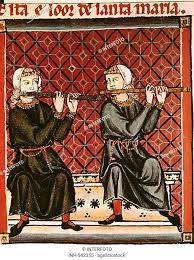
The language of the time, Galician-Portuguese, finds scholars today who argue that Galician and Portuguese are dialects of the same language. It tends to remind one more of Portuguese than of Castilian, the root language of modern-day Spanish. Portugal situated directly south of Galicia, the home of the (K)Celts and the Sephardim of the Iberian Peninsula. Stay with us…
Quarta Espanpie by Ferdinando de Martino Ensemble Comtessa Carmina Gemina: 2:43
End of Hour 2, Segment 1
2:00 minute break.

We continue with Las Cantigas de Santa Maria, the musical biography of Medieval King of Castile-Leon, Alfonso X, the wise and learned. I’m your host, Debra Bolton.
For more perspective of the time, King Henry III ruled England about the same time Alfonso X ruled Castile-Leon, the greater part of what is now known as Spain. While El Sabio ruled his lands with Christians, Muslims, and Jewish peoples living and studying side-by-side with some appreciation and great tolerance, it would not be until 208 years later that Isabella and Ferdinand would expel all non-Christians and the time Christopher Columbus would set sail for Asia but landed in the Americas, which changed extensively the lives that he touched. Before that, well-civilized Indigenous tribes had not yet had contact with European colonialists. The surnames that most people connect with Latin American countries were the surnames of their Spanish conquerors. During and after the inquisition, many non-Christians, Jewish and Muslim people, added the suffixes of –ez, -es, or -os to their surnames. For example, the Muslim man, Alvar, became Alvarez. The Jewish man, Martin became Martinez. Consistent with most surnames, there remained a connection to the family trade or place of origins. The Herrera were Jewish iron-smiths. Those hailing from Galicia, or Galego, were the Galegos. In the present day, an extra “L” was added to make it “Gallegos.”
Santa Maria by Irfan 4:45
CSM #156 by Rocio de Trutos 2:37
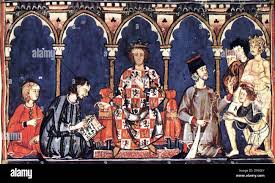
You’re listening to Las Cantigas de Santa Maria on this public radio station. I’m your host, Debra Bolton, and I appreciate that you’re here with me today.
We just heard two pieces, Santa Maria by Irfan, a Bulgarian group focused on electro-acoustic music from a variety of genres and musical centuries. Also, we heard Soprano Rocio de Trutos known best for her Bach Cantatas. You’ve been listening to Las Cantigas de Santa Maria, the holy canticles of the Virgin Mary and the musical biography of Medieval King Alfonso X of Spain in music, poetry, and art. I’m the producer and your host, Debra Bolton.
El Sabio, King Alfonso the X ascended the throne of Castile-Leon, now Spain, in 1252 and immediately devoted himself to the creation of new laws, the Siete Partidas (seven parts) and the Fuero Real (Royal Municipal Code), both of which continue to be in effect here in the 21st Century.
Scholars posit that the CSM continue to be a testament by which the king wished to be remembered after his death. That means that we, also, are part of the intended audience. Knauss continues that the learned king, likely, did not fathom this kind of dissemination, now in this digital age. She says, “With these technologies, it grants scholars who study the CSM a place in his highly exclusive circle of apprentices.”
I began exploring the history of the CSM, because I found the tunes, songs, poems, and art pieces so wonderfully extraordinary with their passion and multimedia approaches. I hope you’ve found this music and its stories interesting. For more information, please visit my blog: https://wordpress.com/post/peopleandcultures.blog/1728
And, if you’d like to hear the show, encourage your local public radio station to run it, and it can be found at the Public Radio Exchange, PRX.
Rosas das Rosas – The New York Consort for Poetry and Music 3:24
CSM #383 Jordi Savall and Hesperion XX 8:14
Rose of Rose CSM Waverly Consort 3:27
Thank you for listening to Cantigas de Santa Maria, I’m Debra Bolton.

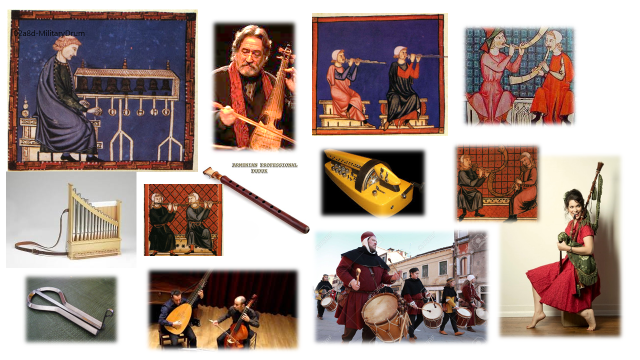
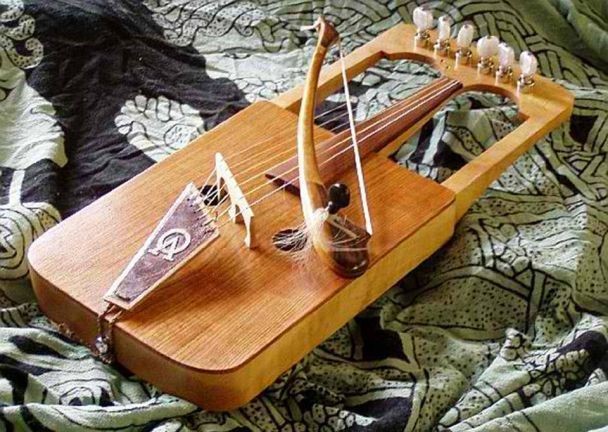

Thank you for reading my blog.
